The Beetle’s been crushed.
(Sorry – we couldn’t resist!)
Now that we have your attention, the generation-defining Volkswagen Beetle has reached the end of the road, the final destination, the great big impound lot in the sky. After over 70 years of production, the last Volkswagen Beetle will roll out of the factory in Puebla, Mexico, and only resurface thereafter in period movies about 2004.
We know: we’re sad too. It’s iconic, and since there are still Nazis around in 2019, we might as well have Beetles, which are definitely nicer to look at than Nazis. As Herbie draws closer to the finish line, we thought it would be good to go through the Beetle’s advertising history – Nazis, CO2 emissions scandals, and strange co-star performances with Lindsey Lohan all included (we’re not serious about that last one).
Nazis? Nazis!
Okay, so there’s no real way around this: the Beetle was intended to be a symbol of Nazi propoganda. It just … never got off the ground.
In 1934, Adolf Hitler wanted a car that would be to Germany what a 1926 Bentley is to Good Omen fans: something durable, that could carry a family of five, and that you could hurtle through the apocalypse while it was on fire. It was designed by an Austrian automotive engineer by the name of Frederich Porsche who almost definitely didn’t make anything wor—yeah, he founded Porsche, and created a series of weapons to help the German war effort, although apparently equipping tanks with antifreeze hadn’t been on the list of things Porsche implemented. He also designed this Beetle prototype, based on Hitler’s requests:
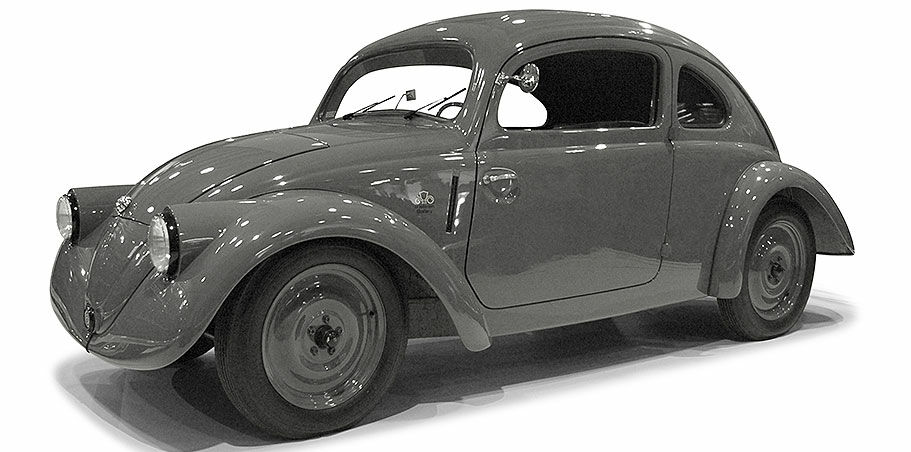
That was in the 1930s. It was even supposed to have the less-wholesome, more-Third-Reich leaning name KdF-Wagen, unfortunately World War II hit the brakes on the Beetle’s production, and by 1938, there were very few Beetle cars on the road, and a hell of a lot of factories dedicated to building vehicles for war, two of which were also Beetle-esque.
Type 166 Schwimmwagen

Type 82 Kubelwagen

Let’s fast-forward a few years: Germany lost, the Good Guys took over the country, and in a very Un-Good Guy move decided to also seize the means of production*, which meant that German car factories could not exceed 10% of the production of 1936. The only solution was to take the VW plan under US control.
Some other stuff happened – American and the United Kingdom playing hot potato with the Volkswagen plant, highest-bidder buyers turning down the opportunity to own Volkswagen, a man crawling between precious equipment to remove an unexploded bomb – and the VW company was back in business! Fast forward to 1949, and the Beetle was imported to the United States, where sales kind of stopped at two.
As in, two cars. Two singular automobiles.
By the time it hit Doyle Deyn Berbach’s portfolio, Volkswagen hadn’t sold many more than that. At the time, when it had to compete with behemoth vehicles like the Plymouth and the Bel Air; the Volkswagen was small, ugly, and had been made by literal Nazis. Try and imagine selling that to 1950s America, so proud of their involvement in the war that the Call of Duty series has been going on longer than the actual war.
So, DDB had a problem, and they couldn’t really solve it like Maria; the advertising industry at the time had built itself on playing-card-castles of promoting beauty, promoting functionality, making their product the centre of a consumer’s life. Cars sold in America in the 1950s were fashion statements: beautiful, dangerous, testosterone-pumping, music-blastic fashion statements.
The Volkswagen was none of those things*.
What it was, as Bill Bernbach wrote after a factory visit, was ‘honest’. Detail and a lot of care went into creating the Volkswagen Beetle; many people relied on the factory for work, and they took pride in their work, they took pride in making it.
The Ad
Great minds made the ad; serendipity made it work. The automotive industry in 1959 was starting to collapse under itself, the recession calling for smaller, compact, more affordable cars rather than gas-guzzling beasts. A competing ad company, Ogilvy, had already perfected the ad format: short, effusive, logo-free, illustrations aplenty.
DBB released this:
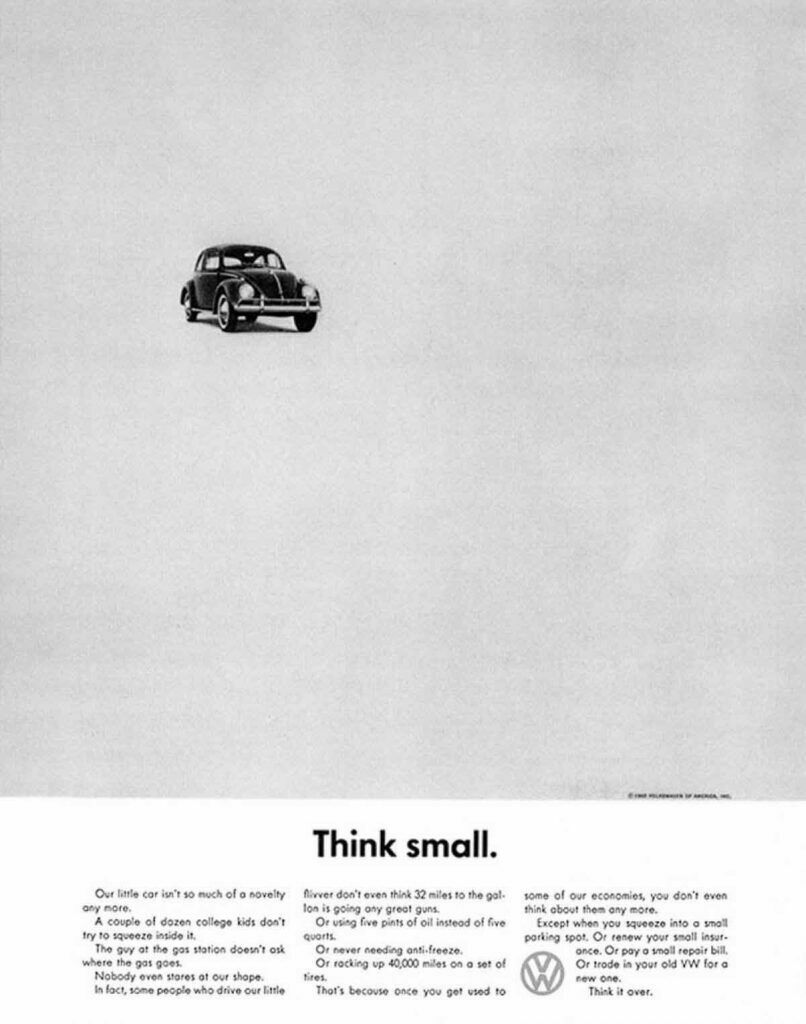
Bill Berbach wanted to give the people an honest ad. This was an honest ad: the copy was an honest understanding of the VW’s limitations.
‘Our little car isn’t so much of a novelty any more’, it said, and went on to describe all the ways the Volkswagen Beetle was not, in fact, a novelty: it couldn’t fit a lot of people in it, it didn’t take a lot of gas, it didn’t go a huge distance, it wasn’t fast. The image with the VW Beetle shrunk down to less than a quarter of the space. The logo dropped right in the middle. The sense that someone, somewhere, was playing a practical joke. At the end, it said what the Beetle could do: it was affordable, and easy to trade if something happened, and you could find parking anywhere.
Opening up your newspapers in 1960s and finding that ad, mocking but not mean, honest but not cruel, was a breath of fresh air. Advertising had been promising gold and delivering gild for a while; an ad that did what it said on the tin was incredible, and people really, really, really liked it. People carried the ad around with them like pictures of their kids — and no, we’re not joking. They bought the magazine just to own the ad. As with a lot of things, the ads attracted the attention of the young, and VW sales soared.
Nobody, least of all art director Helmuth Krone, who hated it so much he went on holiday and came back expecting to be criticised. Instead, the ad launched his name as the pioneer of modern advertising.
Volkswagen didn’t look back.
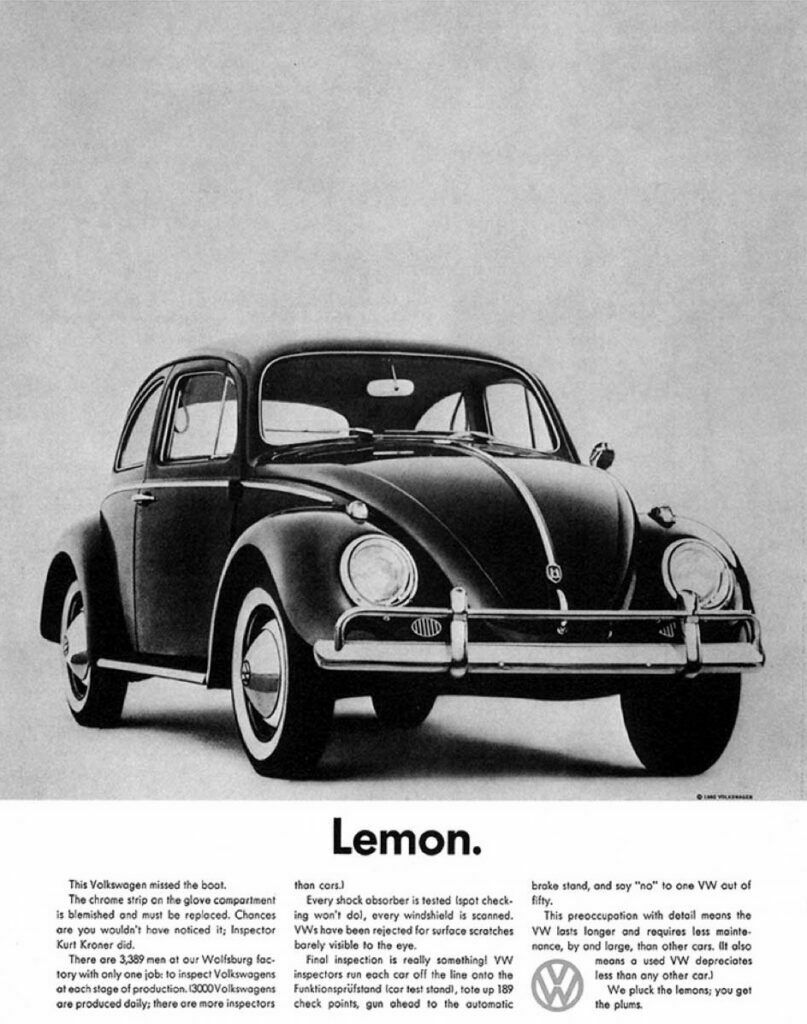
Today, ‘Think Small’ is immediately recognisable. Volkswagen fame and popularity in the United States was built because of these ads, whether they were telling people that the design of the Volkswagen hadn’t changed in 10 years, or that the Volkswagen was waterproof. For people, it released them of the need to have the latest innovation, the most expensive beauty, and to go for reliable, to go for affordable, to go for good enough. The war had come and gone, and the hold-over of ‘everything is fine’ had started to fray; to have an ad that actually spoke the truth to the teenagers and young adults who’d grown up in the shadow of the war brought to life a new, revolutionary spirit.
Volkswagen was in, and the Beetle was the car to be(etle).
Modern Day
Okay, so it hasn’t been all plain-sailing. The CO2 Emissions scandal put a dent in the Beetle’s popularity.
Now, it’s been four years, so here’s a tl; dr summary of the Volkswagen CO2 emissions scandal: basically, the Environmental Protection Agency, which does things like monitor CO2 emissions on vehicles and overfishing and air pollution, found that VW cars in America had software that changed the outcome of results when diesel engines were tested, therefore kind of making the whole point of testing them useless. VW came clean immediately, and admitted that they’d been fudging the results of emission tests in the US, with over 11,000,000 cars worldwide fitted with this software.
Why was this a big deal? The US has a limit of how much nitrogen oxide pollutants it can emit, and Volkswagen’s fudging with the tests meant that it was exceeding that amount by 40 times as much.
Let’s all say a great big ‘yikes’ for the ozone layer, folks.
It started in the US, but as with all negative news, it spread like wildfire to Europe, with cars also being tested in Germany, France, Italy and the United Kingdom.
Running ads like this to promote their vehicles also made it like 10,000 times worse.
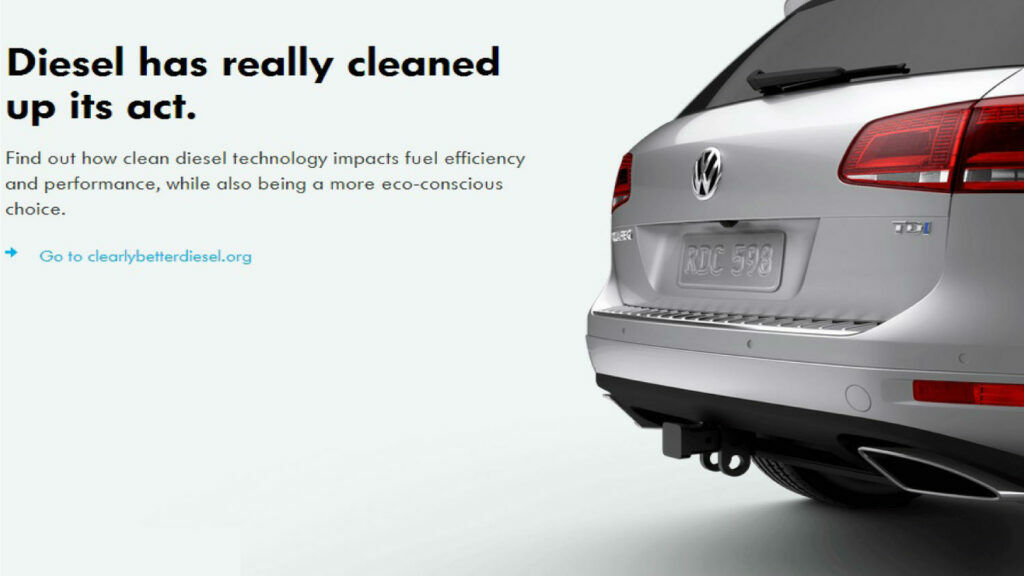
Anyway, let’s learn a valuable lesson about this: don’t lie about your product. Absolutely don’t lie about your product when people can catch you out. Absolutely, absolutely, don’t lie about your product and say it’s safe when in reality it’s emitting dangerous levels of nitrogen oxides that can lead to a bunch of premature deaths.
People, like Oliver Schmidt, an engineer, were jailed. Volkswagen paid up to $25bn to the United States authorities in fines, penalties, and fees for just 580,000 vehicles; Volkswagen’s profits dropped dramatically in the interim, and not only that, but so did other diesel-car companies. That whole ‘clean energy’, electric car, hybrid-vehicle mania?
Yeah, welcome to what did it.
In the days after the VW emission scandal, a series of other-lawsuits and accusations broke out against different diesel-car companies: Chrysler, General Motors, BMW. Nobody wanted to make another Volkswagen mistake, and the razor-thin profits that car companies made on a good day couldn’t withstand constant scrutiny and testing.
By contrast, companies like Alphabet (Google’s parent company) and Tesla had huge stock leaps for their clean-energy electric cars, surpassing the decades-old automakers that had taken over the car industry.
Aftermath
Volkswagen’s struggled to recoup losses after the diesel scandal; because of the number of cars affected, it’s had to buy-back, recall, or repair cars in batches, and admitted it could take ‘years’ to fix. Thing is, Volkswagen’s industry is still not sustainable – people are switching to all-electric vehicles that are cheaper to run and are becoming more affordable to buy.
Naturally, Volkswagen recently released an ad for their newest offering, an all-electric concept vehicle called the ID Buzz.
And, naturally, they did it with this tagline:
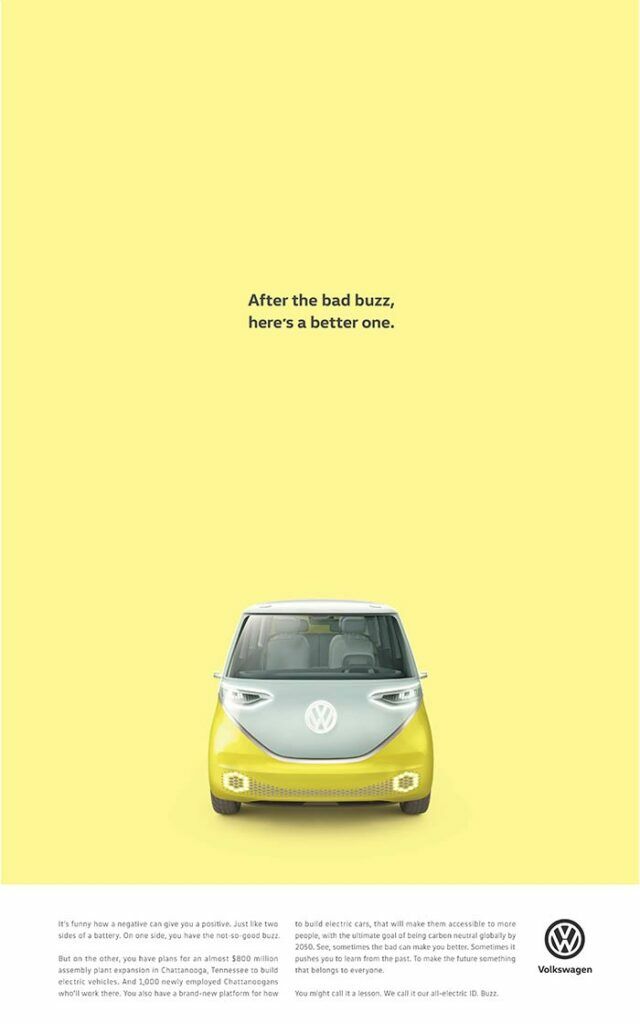
Notice anything? Let’s scroll back fifty years or so:
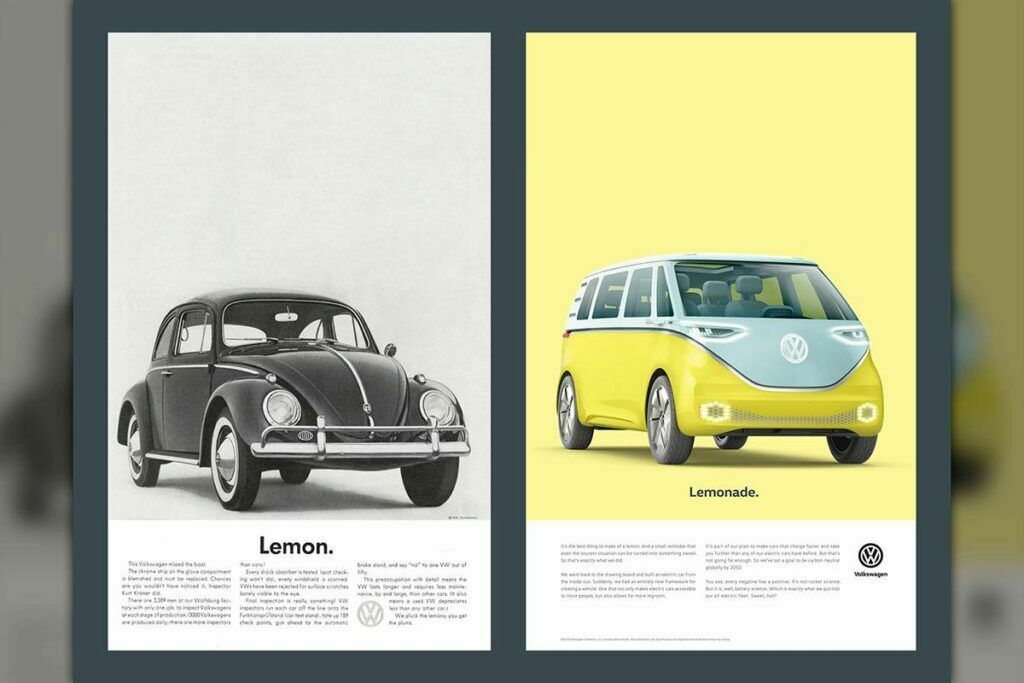
Now you’re getting it.
Language Breakdown
For their new ID Buzz, they recreated the Lemon ad, one of the most influential ads of all time. Brighter colours, same voice, same logo, same everything, for a nostalgic whiplash return to when Volkswagen was the hot new thing on the market and people printed out their ads to hang on their bedroom walls.
Here’s a better look at it:
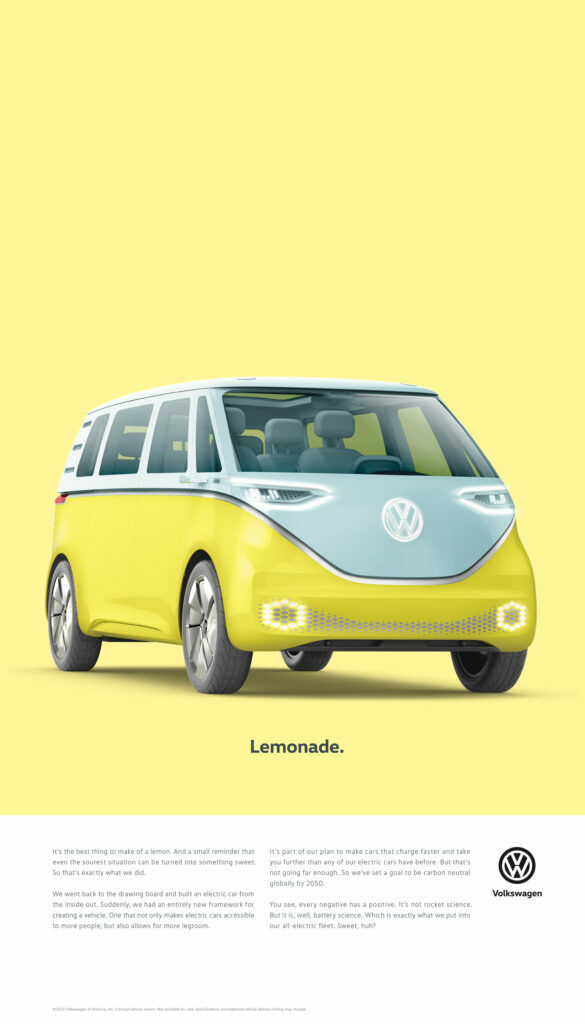
If you can’t read the text, the first paragraph: ‘It’s the best thing to make out of a lemon. And a small reminder that even the sourest situation can be turned into something sweet. So that’s exactly what we did.’
Compare it to Lemon, 1960: ‘This Volkswagen missed the boot. The chrome strip on the glove compartment is blemished and must be replaced. Chances are you wouldn’t have noticed it; Inspector Kurt Kroner did.’
On the surface, same voice; if you break it down a little bit more, it’s different. The first one’s bragging, shedding-light-but-not on the situation with the emissions scandal. Look at us, we’re doing the right thing! Look at us, we’ve definitely learned our lesson! It’s not quite honesty, not quite lies. With the emissions scandal behind it, it’s hard to tell if Volkswagen is genuine, but it definitely doesn’t come off as genuine.
Scandals can break a company. Volkswagen’s been limping by, but the emissions scandal might take more than decent advertising to clear up – especially considering that they were found unequivocally guilty.
Lemon, 1960: ‘we fucked up this car and fixed it before it got to you’ just about sums it up. It owns a lot more of the Volkswagen’s initial fuck-ups, problems in manufacturing, etc, and most importantly – the emissions scandal hadn’t happened it.
Does the Lemonade ad work?
The problem with recreating an old ad into a new one is kind of obvious: you can’t turn back the clock and make whatever your company did go away by the pure semblance of Good Advertising. We’ve talked a lot before about how companies are being held responsible for their actions – and Volkswagen isn’t any different from any of them. ID Buzz hasn’t generated any, well, buzz. How could it? Scandal doesn’t go away because you bring out an ad styled in what made you great.
The most the ads do is show promise that things have changed and are improving. Whether that’s enough to lift Volkswagen out of the downward spiral it’s been in will take longer to show.
Give us the breakdown
Don’t lie about your product, and good advertising isn’t always going to be enough to save you. With a scandal this huge, it’ll take more than clever copywriting to dust off the dirt and mud – but there is a way out, and that clever copywriting is going to come in handy. It’s just also going to take money, initiatives, and a repeated and concentrated effort to show that Things Have Actually Changed. Most of the takeaways for this is the same as we’ve said before – if you have some dirt to your name, invest in cleaning it up yourself, not hiring copywriters to do damage control after the damage has happened.
Footnotes:
*The Morgenthau plan was a very, very rational reaction to a traumatic experience: they didn’t want what happened in World War II to happen again, so a plan was created to ‘pastoralise’ Germany. It also crippled the economy of Germany, and turned East Berlin into a veritable wasteland of suffering, but the history books don’t like to talk about it.
* The New York Times called it ‘beetle’. Other people called it ‘baby Hitler’, which is considerably less cute.




